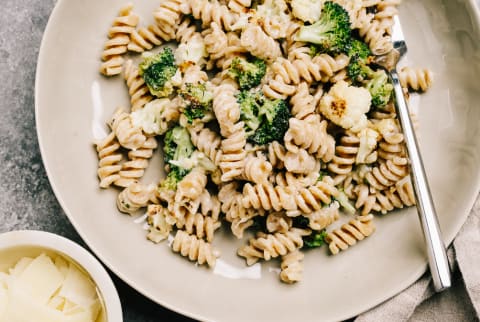Advertisement
4 Healthy Noodles To Give Your Pasta Dishes An Upgrade


Humans have craved noodles since they were invented centuries ago. After all, they're pretty amazing—noodles are easy to make, incredibly satisfying to eat, and endlessly versatile. And these days, there are just as many varieties of noodles as there are ways to make them. As a nutritionist and wellness expert, I've tried a number of healthy noodles and pastas over the years, and there are certainly a few favorites that stand out from the rest:
Chickpea-based pasta
The arrival of chickpea-based noodles a few years ago was a boon to pasta lovers everywhere. They cook like regular pasta but are gluten-free and offer more nutrients. The noodles have twice the amount of protein, more than double the fiber, and 30% fewer net carbs than your typical bowl of pasta. Brands like millennial fave Banza offer tons of variety, like spaghetti, penne, and even hard-to-find shapes like casarecce.
Flavor: Slightly nutty.
Consistency: Firm when cooked and similar to wheat pasta. Just don't overcook them! They can get mushy and stick together.
Best use: Use them in your favorite hot or cold pasta dish.
Whole wheat pasta
For pasta lovers who don't need to avoid gluten but are looking for something heartier and more nutritious than traditional semolina pasta, check out a whole wheat option. Barilla has a complete lineup of whole wheat pasta (made from 100% whole grain durum wheat flour) to satisfy every craving. If you compare their whole wheat penne to the semolina version, it's 5 grams higher in fiber and has one more gram of protein.
Flavor: Earthier than its white flour counterpart.
Consistency: Whole wheat pasta has a denser texture than traditional, which may take some getting used to. Some people notice more of a difference with the longer noodles than with shorter shapes.
Best use: Some people find that whole wheat pastas go better with dark leafy greens and pesto versus acidic tomato sauce, but I think they can work in any dish as long as you balance the flavors.
Ancient grain noodles
If you're looking for something a little different to add variety to your noodle rotation, check out ancient grain pastas. This category is very diverse and covers everything from pastas made with quinoa to ones crafted from kamut. They are often blended with other grains, like the ones from Ancient Harvest, which combine organic corn and brown rice with organic quinoa to create gluten-free rotini, shells, and other shapes. Most varieties offer around 3 grams of fiber and 4 grams of protein.
Grain blends can be an easy way to try ancient grains. Ronzoni's Ancient Grains penne blends whole wheat with quinoa, amaranth, millet, sorghum, and teff for a delicious pasta that holds up well in baked dishes and pasta salads. It's a nutritional winner as well, with 8 grams of protein and 5 grams of fiber in each serving.
While many of these pastas are gluten-free, keep in mind that spelt, einkorn, and farro are ancient types of wheat—therefore, any noodles made with these grains are not suitable folks who need to avoid gluten. But they are delicious alternatives, especially farro, which is quite nutty and goes well with strong cheese, like feta, and toasted walnuts.
Flavor: Depending on the variety, the flavor can vary from earthy to nutty to mild.
Consistency: Expect a slightly firmer consistency than traditional wheat pasta.
Best use: You can use them in any way you would typically use pasta.
Shirataki noodles
Unlike most types of noodles, this variety you'll find in the refrigerated aisle instead of the pasta aisle. Shirataki are made of water, konjac flour (an Asian root vegetable), chickpea flour, potato starch, and calcium hydroxide (a preservative). Some brands are made with tofu instead of chickpea flour.
Shirataki are vegan, gluten-free, and also high in soluble fiber, which helps you feel full. The Nasoya brand contains 3 grams of fiber per two-thirds of a cup (some brands are even higher). For folks who are keeping track of carbs, these noodles are a dream—only 5 grams of carbs per serving.
While shirataki shine in the fiber department, they don't contain any protein, so you'll want to add some diced tofu or beans to your dish.
Flavor: They don't have any flavor on their own, so pair them up with flavorful sauces, such as teriyaki or peanut-ginger.
Consistency: The consistency is a bit rubbery, which takes some getting used to.
Best use: Shirataki have a funky smell right out of the bag, but if you give them a rinse with water, it quickly dissipates. Preparation is easy. You can either parboil for two minutes, sauté in a pan, or even microwave the noodles for a minute or two.